Ice chests are passive devices that keep food cold as long as they are stocked with sufficient ice.
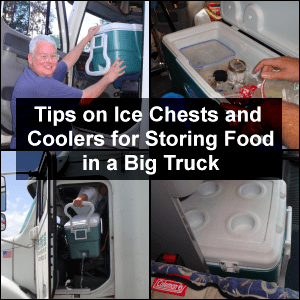 They do not depend upon refrigerant, a compressor or a source of energy to work.
They do not depend upon refrigerant, a compressor or a source of energy to work.
Also known as ice coolers, there are several different kinds available, all of which utilize a layer of insulation to protect the contents from warming to the surrounding temperature.
We provide on this page:
- the advantages and disadvantages of using ice chest coolers,
- our experience in using them in 18-wheel tractor trailer trucks, and
- component information that you as a professional driver can use to make an informed buying decision.
Our Experience with Storing Perishable Food
As a part of our meal preparation, and to ensure well-balanced meals in our truck, we buy certain perishable foods like milk, cheese, eggs, fresh fruits and vegetables, and meats.
Some of these items must be kept at temperatures of 40°F or below, the same temperature at which home refrigerators should be set.(*)
During our years of professional driving, we have used the three most popular types of coolers:
- thermoelectric coolers;
- compact refrigerators; and
- ice chests.
For consistently cold perishable food storage, we have found that using an ice chest beats the others, hands down.
Here is what we have found in general:
Advantages
- Durable (except standard Styrofoam coolers);
- Not dependent on refrigerant;
- Not dependent on an energy source (12-volt or inverter power) and;
- Available in many shapes, sizes (capacities) and colors, with different features.
Disadvantages
- Must continually be stocked with ice that continually melts;
- Water from melted ice must be drained off periodically (perhaps being recycled for other uses);
- Food not properly sealed can be soaked or water logged;
- Can be very heavy depending on size and contents (see our disclaimer below);
- Plastic parts (such as drain plugs, hinges and handles) can break; and
- Drain channel or wheel well may limit the ability to pack or stack contents evenly.
Contrast these three different kinds of coolers
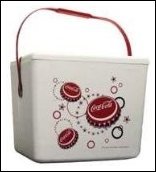 Styrofoam ice chest
Styrofoam ice chest
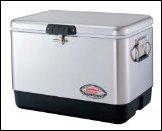 Steel belted ice chest
Steel belted ice chest
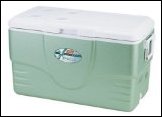 Plastic insulated ice chest
Plastic insulated ice chest
Years before the Coleman Xtreme or Igloo MaxCold lines of coolers became available, we started out by using a regular 36-quart cooler, then moving up to two regular 48-quart models (which we used one at a time).
For both of these sizes of ice chests, the ice melted off fairly quickly.
The interior plastic lining cracked on the first 48-quart unit (the kind of field failure we considered irreparable).
When the drain spout broke on our second, we looked for and could have replaced just that part.
However, we took the opportunity to go looking for a newer ice chest and found that some models are advertised to keep food, beverages and ice cold for up to a certain number of days, up to a specified outside temperature.
We visited a sporting goods store with a wide selection of ice chests and found a Coleman 6-Day Ultimate Xtreme Cooler.
At the time this page was written, there were two versions of this cooler, one with wheels and one without — both shown here from Amazon.com, with whom we have an affiliate relationship.
Coleman 6-Day 50 Qt. Ultimate Xtreme Wheeled Cooler
Exterior: 31.50″ x 18.25″ x 16.13″
Interior: 16″ x 8.5″ x 12″
Product Dimensions: 30 x 17 x 15.2 inches
Weight: 21 pounds
Coleman 6-Day 58 Qt. Ultimate Xtreme Cooler
Stated measurements: 18.25″ x 31.25″ x 16″
Interior: 22.75″ x 8.5″ x 12″
Product Dimensions: 27 x 18 x 17.5 inches;
Weight: 17.6 pounds
The one with wheels has less interior storage space than the one without wheels (we assume because of the wheel well).
We bought the Coleman 6-Day 50 Qt. Ultimate Xtreme Wheeled Cooler because of the wheels.
Mike says that it has 2 inches of insulation all the way around.
We told the cashier that we would be “field testing” the claim that it would “keep food, beverages and ice for up to 6 days at outside temperatures up to 90 F.”
Indeed, the ice stored in it melts more slowly than in our other coolers.
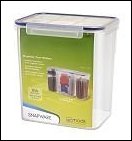 We overcame the “soaked food” problem (brought on by melted ice water seeping into supposedly sealed plastic bags) by storing bagged items in a separate Snapware container, like that pictured, that fits perfectly inside.
We overcame the “soaked food” problem (brought on by melted ice water seeping into supposedly sealed plastic bags) by storing bagged items in a separate Snapware container, like that pictured, that fits perfectly inside.
We have found that it is easier to clean the “textured” surface of a plastic cooler outdoors with dishwashing liquid, a scrub brush and running water from a hose than it is to clean it inside at a sink or in a bathtub.
Before you buy your ice chest, you will want consider these components. Some will be more important to you than others.
Components of Ice Chests
- Regular cooler vs. “marine” cooler;
- Quarts of interior capacity size (sometimes advertised by the number of cans it can hold;
- Exterior material (plastic, metal or foam);
- Interior liner material (plastic, metal or foam);
- Hinge material (plastic, metal or none if detached lid);
- Insulation material (fiberglass, polystyrene (Styrofoam), or urethane);
- Interior (full or split);
- Type of lid (full or split, tie down grooves or not);
- With or without wheels for rolling;
- Handle type (strap, plastic or metal; recessed or not; two way or not);
- Temperature claim (keeping ice up to X days at temperatures reaching Y degrees Fahrenheit);
- Exterior dimensions and color;
- With or without separate internal tray;
- Type of drain spout (channel drain for no-tilt draining of liquid or not);
- Lid type (level or not; gasket sealed or not; latched or not; with or without built-in drink holders);
- Weight (empty and loaded);
- Overall durability (can support weight of X pounds on lid, such as when being sat on);
- Check suitability of storing specialty products (such as dry ice); and
- Cost.
Breakage
After more than a year’s constant usage, Mike experienced a field failure with one of the hinges on our Coleman Xtreme ice chest. You can read all about Vicki’s temporary fix and then permanent replacement of this Coleman cooler hinge.
Ice Chest Disclaimer
Every food has a “shelf life” or “expiration date” associated with it.
Keeping foods cold can help extend their usability and freshness but will not prevent foods from eventually spoiling.
So, practice wisdom with regard to eating the food you store in your ice chest.
Rotate foods as they should be rotated and discard foods that need to be discarded.
Also, you will want to avoid using a cooler that you have to lift if you have back problems of any kind.
Never lift more than you can handle.
![]() Money saving tip: Although some ice chests can be quite pricey, they may end up saving you money in the long run if you plan to eat meals in your truck.
Money saving tip: Although some ice chests can be quite pricey, they may end up saving you money in the long run if you plan to eat meals in your truck.
Compare prices, sizes, and capacities to get the best buy for you.
A lower priced model that is not as well insulated as a more expensive but better insulated ice chest now may not translate into the kind of cost savings you desire.
Return from Tips on Ice Chests and Coolers for Storing Food in a Big Truck to our Meal Preparation page or our Truck Drivers Money Saving Tips home page.
Reference:
* www.fsis.usda.gov/wps/portal/fsis/topics/food-safety-education/get-answers/food-safety-fact-sheets/safe-food-handling/refrigeration-and-food-safety/ct_index (no longer online)









